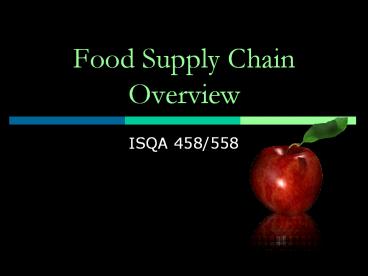Food Supply Chain Overview PowerPoint PPT Presentation
1 / 28
Title: Food Supply Chain Overview
1
Food Supply Chain Overview
- ISQA 458/558
2
Food Supply Chain
- Structure
- Definition
- Trends
3
The Supply Chain Players
Consumer
Retailer
Food Service, Schools or Gov.
Wholesaler, Distributor, Agent or Broker
Food Beverage Manufacturing
Farm, Ranch, Fishery or other provider Agricultura
l Producers
4
(No Transcript)
5
Food Producers (raw materials)
6
- Number of Farms increasing for vegetables, crops
and hay, animals eggs, but declining for most
other things.
7
Trend toward more small and very large farms,
loss of the middle Segment (family farms versus
corporate farms)
8
Farmers Producers
- gt 2.1 million farmers ranchers
- 125,000 of them control 75 of production
- Sales 375 Billion
- Focus
- 650,000 cattle ranchers
- 500,000 hay farmers
- 330,000 grain and oilseed farmers
- 100,000 fruit and nut farmers
9
Food Manufacturers and Processors
- 26,000 companies in US 540 Billion in Sales
- Meat products 18.5
- (4 firms control 80 of market)
- Bakery 16.6
- Fruits Vegetables 14
- Dairy 10.7
- Sugar, candy, grains, oilseeds, seafood. Etc.
- Make up 70 of grocery sales, 10 are
unprocessed, and remainder non-food - 100 large firms control 75 of all processed food
10
Wholesalers, distributors, agents and brokers
roles
- Whole group 33,000 players (600 B)
- Wholesalers/Distributors
- Purchase groceries and related products from
processors or growers and resell to retailers,
institutions, and other companies - Manufacturers sale branches
- Wholesale operations maintained by processors to
market their own products - Agents Brokers (w/ above 4700)
- Wholesale entities that buy or sell as
representatives of others for a commission and
who do not usually handle the product.
11
Food Service Vendors
- 580,000 vendors (580 B)
- 40 full service restaurant
- 37 limited service
- 6.1 education
- 4.4 hotels
- 580 Billion in sales
- 3 companies control most food service management
contracts - ½ spent on food away-from-home typically at
full-service or fast-food restaurants
12
Retailers
- More than 210,000 stores
- (sales 584 Billion)
- 32,000 Supermarkets (stores with sales gt 2
Million) - ¾ of all grocery stores are operated by corporate
chains - Retailer power - 4 retailers 40 market share
- Typical store has 25,000 items and inventory
turns 14 times/yr - Produce turns 58 times/yr
- Non-food turns 4-6 times
13
Logistics Providers
- Cover movement, storage, management of inventory
- Transportation
- Storage facilities
- Third parties for managing products and
information - 800,000 warehousing and transportation firms.
- Increasing outsourcing to third parties
14
Driving Forces and Trends affecting the industry
Consolidation of the Supply Chain Technology Regul
ation Environmental Factors Management
Orientation/philosophy
15
Consolidation
Corporate Farms
Mega-Manufacturers
Largest Chain Restaurants?
Largest Grocery Retailer?
16
Largest Chains by Number of Units?
- Subway, 24,722
- McDonalds, 14,098
- Starbucks, 10,821
- Pizza Hut, 7,600
- Burger King, 7,231
- Dunkin Donuts, 7,015
- Wendys, 6,594
- Dairy Queen, 6,187
- Taco Bell, 5,670
- Dominos Pizza, 4,907
- Who would be number one in sales?
- McDonalds (34 Billion in 2011)
17
Example Brands
- Consolidation of Organic Natural Food
- Horizon
- Kashi
- Ben Jerrys
- Nantucket Nectars
- Celestial Seasonings
18
Consolidation Animationhttps//www.msu.edu/howar
dp/organicanimation.html
19
(No Transcript)
20
What does this consolidation mean for the supply
chain members?
- You are a food product innovator and want to
bring your product to market? - How might consolidation create interesting
business opportunities?
21
Who is The Food Industry???
The Food and Agriculture Industry Farming
Growers Raw Ingredient Processors Function Food
Ingredient Manufacturers Consumer Packaged Food
Manufacturers Distributors Retailers
(traditional/non-traditional) Foodservice
Establishments
Non-Food Industries Chemical Suppliers Utility
Suppliers Packaging Suppliers Equipment
Manufacturers Transportation Industry Analytical/T
esting Environmental Industry Information
Management
Key Constituents Government Agencies/Political Med
ia Employees/Unions Stockholders/Boards/Wall
Street Advocacy Groups Academics/Foundations Medic
al Community
Consumers
22
Technology
- Integrated systems of
- RFID (Radio Frequency Devices)
- Bar Coding
- Facility Software Management Systems
- Internet (on-line purchasing usage)
- 20 of Food Wholesalers
- 40 of Restaurants
- 15 Food Processors
- Results
- Improved food inventories
- More efficient distribution
- Better customer service levels
- Note Food stock-outs still cost industry 7-12
billion/yr.
23
Regulations
- Government oversight is increasing
- Two main bodies
- U.S. Department of Agriculture
- Food and Drug Administration
- Product Liability Traceability
- Food Tampering/Security
- Import/Export restrictions and trade barriers
24
Environmental Factors The big squeeze
25
Environmental Factors
- Pesticide and Herbicide use
- Excess Fertilizer and animal waste runoffs from
large farms - GMOs
- Others?
- Leads to supply chain shifts practices,
certification, market opportunities, regulation
increases, and purchasing policy changes.
26
Management Orientation/Philosophy
- Food Industry slow adopters of philisophy from
mainstream manufacturing - Just-in-time JIT
- Sustainability
- Quick Response or Efficient Customer Response
(ECR) - Collaborative planning, forecasting and
replenishment
27
New Performance Assessment/Metrics
- Better, faster, cheaper
- Environmental, animal treatment, wild lands,
community commitment
28
Other trends
- Shift in power from food manufacturers to food
retailers - Increases in the number and scope of vendor
participation programs - Increases in slotting fees (fees charged to
manufacturers to rent shelf space in the retail
store).

